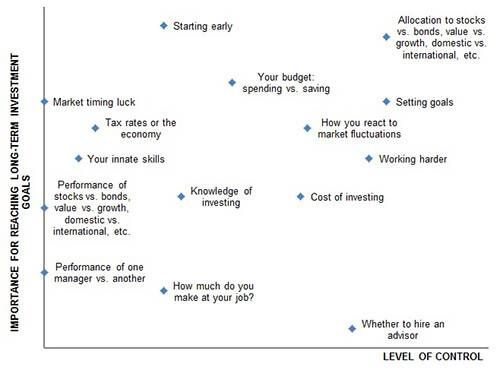Take This Zen Approach to Long-Term Investing
The key: Focus on what you can control, not what you can't
(This article previously appeared on the American Institute for Economic Research site.)

There is one core tenet to my investment philosophy: Focus on important factors that you can control, and let go of the ones you can’t.
In the exhibit above, these are the factors in the upper right hand corner of the chart and include:
- Cost of investing: Although there will be some cost of investing in funds, this factor is largely within your control and finding reasonably priced funds is critically important to your long-term success. For example, if you invested $250 per month over the course of 30 years, an extra 1 percent in fees would reduce your end portfolio value by somewhere around 17 percent!
- Setting goals: By setting appropriate goals and working toward them, you will vastly improve your chance of success.
- Your asset allocation: Research suggests that asset allocation explains over 90 percent of performance. This will be an important driver of your long-term investment success, and you have complete control over it.
- Your budget: How much you save is hugely important to how much you end up with in the end. After all, you can’t invest what you don’t save.
- How you react to markets: Although our human nature compels us to run away after markets have fallen, the better response is actually to stay invested at precisely the time when it hurts the most.
On the other hand, there are important factors over which we have little control, as shown on the left side of the exhibit and include:
- Market timing and performance: Consider the fate of two investors who started investing just 10 years apart, one in January 1965 and the other in January 1975. Let’s say that they both saved $500 per month (we’ll ignore inflation, taxes, and fees for simplicity) and both maintained passive portfolios composed of 50 percent stocks and 50 percent U.S. Treasuries. At the end of 20 years, the 1975 investor would have had $476,000, and the 1965 investor would have had $336,000.
- Tax rates and the economy: Here’s another factor that will play a big role in your investment success that you have little to no control over (although you do have some control over how you allocate your resources for tax efficiency).
Advice for Investors
You may think that the market will tank because China’s economy is slowing or that gold will skyrocket in value because inflation is due for a spike or that bond yields have nowhere to go but up. But the market doesn’t care what you think.
You might be right and you might be wrong. A prepared investor will plan for multiple scenarios and focus on what can be controlled.
Since you can’t control or predict what the market will do, you should develop a process and a plan for how you will react, or not react, over time.
There’s no use in beating yourself up about missing out on something that happened in the past. What matters now is what happens in the future. The good news is that factors you can control are often more important than the ones you can’t.
So, focus on saving as much as you can, reducing your investment costs, furthering your career and controlling your emotional reaction to markets.
All of these are within your control and will help you become a better long-term investor.

